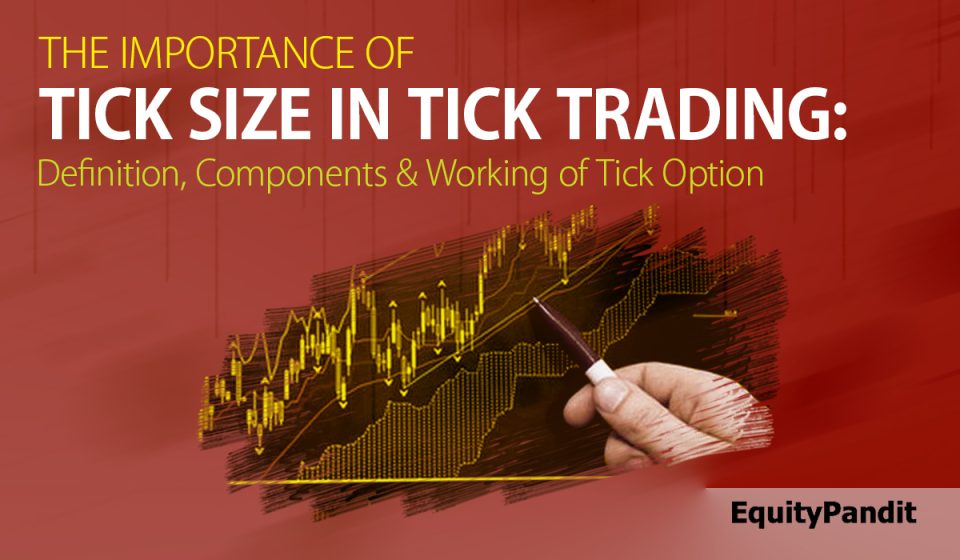Introduction and Meaning of Tick Size
Tick size is the smallest possible upward or downward movement in the price of a security. It can also indicate a change in the cost of security from one trade to the next. Tick size is a crucial measure in security trading.
The price of a security can fluctuate based on a tick, which sets the standard for these fluctuations. A tick represents a specific price increment in the market’s local currency where the security is traded, determining how much the overall price can change.
Understanding tick size is important for investors. It’s crucial for investing money and tracking trends. Tick size and stock price movements determine when to enter and exit the market. This helps to make profits.
For example, a Rs. 0.10 drop in stock price has a different impact than a Rs. 10 drop. A larger price change or tick size increases volatility and requires careful planning to avoid losses. By understanding tick size and movement, investors can predict price changes and have a better chance of making profits.
What is Tick Trading?
Tick trading, also known as tick-based trading, involves taking advantage of small price movements defined by the tick size.
This strategy is commonly used in markets with specific tick size regulations, such as the Indian stock market, supervised by the Securities and Exchange Board of India (SEBI).
Traders who use this approach closely monitor the smallest price fluctuations. They make rapid and frequent trades based on these movements.
How does a Tick Trading work?
Tick trading involves understanding the minimum price movements of different financial assets. Each asset has a specific tick size that determines the smallest price change.
Tick sizes vary between asset classes and exchanges. For instance, on the National Stock Exchange in India, the tick size for stocks can range from Rs. 0.05 to Rs. 1.
If a company’s shares are trading at Rs. 10 each with a tick size of Rs. 0.05, the smallest change in share value for positive price movement would be Rs. 10.05.
Conversely, Rs. 9.95 would be charged for negative price movement. Understanding tick trading involves examining key components.
Components of Tick Trading
Tick size – the building block
Tick size is the basic unit of measurement. Traders carefully monitor price movements in tick increments, aiming to capitalise on small fluctuations in asset prices.
Precision and speed – the winning combination
Tick traders operate with remarkable precision and speed. They swiftly execute multiple trades within a short timeframe, aiming to seize upon rapid market movements that would be missed by those employing longer-term investment strategies.
Scalping – seizing quick opportunities
Scalping is a popular technique in tick trading. Traders seek to exploit the bid-ask spread and tick size. They make rapid profits by buying at the bid price and then selling at the ask price or vice versa.
Algorithmic and high-frequency trading – the rise of automation
In the era of electronic trading platforms, tick trading often involves algorithmic strategies. High-frequency trading (HFT). Automated systems can rapidly execute numerous orders based on predefined algorithms. Leveraging small price differentials to their advantage.
Tick size in options trading: Working
In options trading, tick size is the minimum price movement of an option. This means it is the smallest possible change in the price of a choice. Understanding tick size is crucial because it directly influences costs associated with trading options.
Tick size plays a significant role in the price efficiency of options. It affects the bid-ask spread, the difference between the highest price a buyer is willing to pay for an option (bid) and the lowest price a seller is willing to accept (ask). A smaller tick size generally results in a tighter bid-ask spread, making it more cost-effective for traders.
Moreover, the tick size is not just a number. It’s a strategic tool. It impacts the ability to execute trades at desirable price levels. This is particularly important for traders who employ specific trading strategies. These require precision in the order of entry and exit points.
Understanding and leveraging tick size puts you in control of your trades.
Tick size is essential when designing custom strategies for options trading. The customised strategy may need to account for the minimum price movement allowed. It also helps to consider the potential impact on trade execution and overall trading costs. Being thoughtful about tick size can make your strategies more effective and cost-efficient.
In addition to price efficiency and trade execution, tick size affects market liquidity. A smaller tick size can increase liquidity in the options market by enhancing trading ease and attracting more market participants. Enhanced liquidity can lead to improved market depth and increased trading activity, ultimately benefiting all participants in the options market.
Understanding the significance of tick size in trading is important for precision, risk management, liquidity assessment, volatility considerations, transaction cost analysis, and regulatory compliance. Traders who understand tick size can navigate financial markets more effectively and execute their trading plans, especially in the Indian stock market, where SEBI sets regulatory standards.
Frequently Asked Questions (FAQs)
What is the meaning of fixed incremental measures in tick size?
Tick size creates a framework for fixed incremental price movements. This tick size feature allows traders to quantify market fluctuations precisely or accurately.
Please state some features that make tick size valuable.
Yes. It helps with accurate decision-making, quantifying returns and risks, setting profit targets and stop-loss orders, etc.
What is tick size in futures trading?
In future trading, the tick size is the smallest possible value variation in the price of a future contract.
What is tick size in forex trading?
In forex trading, tick size refers to the smallest movement in the currency pairs. Small tick-size price volatility provides opportunities for higher profits with higher risk.
What are the challenges in tick trading?
Transaction costs, technological infrastructure, risk management, and market liquidity are major challenges that tick trading can face.
What is Algorithm and high-frequency trading?
With the rise of electronic trading platforms, tick trading often involves algorithmic strategies and high-frequency trading (HFT) that helps measure potential profit in terms of the smallest possible price movement.
Ready to invest like a pro? Unicorn Signals app equips you with 100+ Free tools and knowledge you need to succeed. Download the Unicorn Signals app and gain access to daily stock lists and insightful market analysis and much more!
 Live
Live

